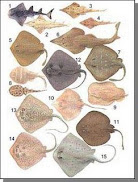Why? A fish’s biological imperative is to conserve energy at all costs. Potential food has to yield a certain level of caloric return to validate the energy cost of its pursuit.
So, put a Sunday dinner spread in front of a walleye and more often that not, it’ll grab those easy calories. It’s like walleyes enter a reactionary mode at some point when confronted with giant baits where they just have to bite. This is the point when biology takes over.
In the 1970s I discovered that walleyes (even two- to three-pound shore lunch fish) are quick to devour giant sucker minnows, waterdogs and other big forage up to a foot-long or more. Taken to its extreme, I was ordering 40-gallons of foot-long salamanders at a time from Carl Lowrance, one of the grandfathers of fishing electronics. Much to my mom’s chagrin, my brother Scott and I kept them outside in a claw-foot bathtub we’d buried in her front yard.
But our waterdog hoarding was for good reason. We had discovered that they’re walleye-catching machines in deep weeds. And we caught some giants, though it soon became a hassle to have waterdogs shipped and trapping them locally was a headache.
But we learned a valuable lesson during our waterdog years. Ramp up in bait size and you’ll catch walleyes, day-in-day-out.
In the ‘80s we moved on to fishing big creek chubs and redtails. At the time, we were convinced redtails were the magic ingredient. But through countless hours on the water, we learned it had everything to do with bait size. To this day, I’ll take a giant creek chub over a medium-sized redtail.
Walleyes As Opportunistic Feeders
Now here’s an interesting phenomenon: Three-pound walleyes will spit out a small shiner but hold on to a giant creek chub all the way to the boat. Kind of like the way a lion sinks its claws into fallen prey to keep it from circling hyenas. It’s Animal Planet stuff: Once a big walleye drops a kill – whether it’s a coughed up shiner, young of the year fish or foot-long chub – another walleye will gobble it up. Fish, like many creatures in the animal kingdom, walleyes are opportunistic feeders.
We discovered this valuable lesson in the turpentine-clear waters of Northern Minnesota. Many times we’d hook a walleye and it’d spit a big, half-digested fish (some giants) on its way to the boat and we’d witness a trailing fish engulf the regurgitation. Again, easy calories.
More Than A Fluke
I started thinking there had to be a soft plastic that would accomplish the same thing we’d discovered using live bait. Taking full advantage of the countless soft plastics on tackle shop shelves, I experimented with everything.
It wasn’t long before I had that ‘Eureka!’ moment when I started playing with fluke-style baits so popular with bass anglers. From that first cast with a white pearl 7-inch Zoom Magnum Super Fluke rigged upside down, it was game on. But since that time I’ve also found the Northland Impulse 5-inch Jerk Minnow is also a solid bet.
The first year I fished it from June into August and caught tons of fish. My first guess was the flukes were just that – a fluke – because that year the thermocline was just starting to set up and fish were holding at the edge of the weeds through mid-summer. So the next year I fished ‘em from ice out to ice up and discovered you could catch walleyes all year long on ‘em. I was dumbstruck.
From a casting perspective, depths between 15 and 25 feet are typically hard to fish. I thought, wow, now finally here’s a bait that works effectively at those depths. I started positioning on deep weedlines, rocks and breaks with even deeper water access. More walleyes – and all sizes – not just big fish, but lots of quality 2-, 3- and 4-pound fish inhaling the giant soft plastics, too!
More Than Match The Hatch
I learned it was more than match the hatch. It wasn’t that walleyes thought they were ciscoes or smelt. Walleyes keyed in on the Magnum Flukes because of size, water displacement and speed, just like a giant creek chub. And when I say speed, it has nothing to do with the bait cadence. It has everything to do with covering water fast…something we wanted to do all along, but couldn’t accomplish with livebait.
The other reason they proved effective is that they represent the kind of scenario walleyes are scanning for 24/7 – a free lunch of dying or wounded meat coughed up by fellow fish.
Here’s the thing, while I experimented with lots of colors, even those that even more closely match forage patterns like shiners, herring and ciscoes, white pearl won out every time.
Why? Solid white mimics the color of the stuff walleyes cough-up, half-digested by stomach acid and on a slow sink. And that’s why rigging the fluke upside down is so important.
Ever watch a wounded baitfish? They kind of twitch and skate along through the water column. With the Magnum Fluke inverted, pops of the rod tip cause the bait to displace water and skate along in a way that suggests stunned, easy-to-eat prey. Besides easy visibility, white Magnum Flukes also have the kind of bulk that a walleye picks up via its lateral line from a long way away.
In between pops of the rod tip, the bait falls in a way that perfectly mimics this dance of the dead. Hence, the presentation became known as a “skate bait,” although my brother jokingly suggested “The God-Awful.”
While the bait looks deceptively simple, correct rigging is essential to put it to work for you.
Rig Your Skate Bait Right
Simply thread a Magnum Fluke upside down on a Northland 3/8- to ¾-ounce silver shiner-colored Mimic Minnow Jig Head and you can attach a Northland three-inch Sting’r Hook as insurance. Then, to make sure the plastic stays on the hook fish after fish, run a bead of Krazy Glue between the head of the jig and Fluke body.
When it comes to rods and line, there are also a couple key components to making the skate bait system win for walleyes.
First, the use of a quality superline like 20-pound Northland Walleye Braid or Sufix 832 on a fast-action medium-heavy spinning rod like a 7-foot medium-heavy St. Croix Legend Xtreme is a must for working this bait. The braid responds quicker at greater depths using a pop-pop-pause cadence, not unlike how you’d fish a deep-water jigging spoon. Plus, it seems to create a better and more seamless skating action.
Also, make sure to attach a three-foot section of 30-pound premium monofilament leader to prevent the shock of the rod action and fish strikes from breaking off your bait. Although you can use a double-uni or other line-to-leader knot, I opt for the no-fail performance of a size 10 or 12 barrel swivel like the Aquateko InvisiSwivel. Attach the skate bait to the mono leader with a palomar knot.
Debriefing
Skate baits have opened my eyes to the untapped potential of casting soft plastics for walleyes. It’s proven to me that paying attention to fish behavior can help anglers build presentation systems that work not only seasonally, but throughout the entire open-water calendar.
Without a shadow of doubt, skate baits and jerk minnow-type baits have proven to me that walleyes will consistently take advantage of a big, free meal, especially something that looks dying or wounded. And, when it comes to size, if you think you’re fishing something too big, well, you’re probably on the right track. Just talk to a few muskie fishermen about when, where and how often they catch walleyes on giant baits!
Over the years, I guess you could say the proof is in the livewell … or at least a lot of photographs.
My next experiment? You got it – ramping up to even bigger soft plastics for skate baiting!



.jpeg)


































